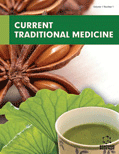Abstract
A staggering 80% of the population in developing countries relies on herbal medicine for treatment of various diseases and disorders. Among them, Achillea millifolium from Asteraceae family is one medicinally important plant called as “yarrow” and reported as being used in folklore medicine for ailments such as skin inflammations, spasmodic and gastrointestinal disorders, as well as hepatobiliary complaints. Therefore, a plethora of scientific studies have been conducted to give substance to its ethnomedicinal claims, and in addition to that, even more, biological functions such as its hypotensive, antioxidant, antimicrobial, vasoprotective, antiulcer and antis-permatogenic activities, scientifically established. Our review comprehensively collects recent phytochemical and pharmacological activities of Achillea millifolium and should, therefore, act a suitable reference for future research into the plant’s phytochemical profiling and overall pharmacological evaluation.
Keywords: Achillea millefolium, phytochemistry, therapeutic uses, pharmacology, constituents.
Graphical Abstract
Current Traditional Medicine
Title:Achillea millefolium E.Mey: Phytochemistry and Pharmacological Profile
Volume: 7 Issue: 3
Author(s): Altaf H. Satari, Mohammad Faizan Bhat, Reyaz Hassan and Mubashir Hussain Masoodi*
Affiliation:
- Natural Product Research Lab, Department of Pharmaceutical Sciences, University of Kashmir, Hazratbal, Srinagar- 190006, J & K,India
Keywords: Achillea millefolium, phytochemistry, therapeutic uses, pharmacology, constituents.
Abstract: A staggering 80% of the population in developing countries relies on herbal medicine for treatment of various diseases and disorders. Among them, Achillea millifolium from Asteraceae family is one medicinally important plant called as “yarrow” and reported as being used in folklore medicine for ailments such as skin inflammations, spasmodic and gastrointestinal disorders, as well as hepatobiliary complaints. Therefore, a plethora of scientific studies have been conducted to give substance to its ethnomedicinal claims, and in addition to that, even more, biological functions such as its hypotensive, antioxidant, antimicrobial, vasoprotective, antiulcer and antis-permatogenic activities, scientifically established. Our review comprehensively collects recent phytochemical and pharmacological activities of Achillea millifolium and should, therefore, act a suitable reference for future research into the plant’s phytochemical profiling and overall pharmacological evaluation.
Export Options
About this article
Cite this article as:
Satari H. Altaf , Bhat Faizan Mohammad , Hassan Reyaz and Masoodi Hussain Mubashir *, Achillea millefolium E.Mey: Phytochemistry and Pharmacological Profile, Current Traditional Medicine 2021; 7 (3) . https://dx.doi.org/10.2174/2215083805666190614112030
| DOI https://dx.doi.org/10.2174/2215083805666190614112030 |
Print ISSN 2215-0838 |
| Publisher Name Bentham Science Publisher |
Online ISSN 2215-0846 |
 11
11
- Author Guidelines
- Bentham Author Support Services (BASS)
- Graphical Abstracts
- Fabricating and Stating False Information
- Research Misconduct
- Post Publication Discussions and Corrections
- Publishing Ethics and Rectitude
- Increase Visibility of Your Article
- Archiving Policies
- Peer Review Workflow
- Order Your Article Before Print
- Promote Your Article
- Manuscript Transfer Facility
- Editorial Policies
- Allegations from Whistleblowers
- Announcements
Related Articles
-
Pyrazolo-Triazolo-Pyrimidine Derivatives as Adenosine Receptor Antagonists: A Possible Template for Adenosine Receptor Subtypes?
Current Pharmaceutical Design Effects of <i>Nigella Sativa</i> (Black seeds) Supplementation on Plasma Lipid Profile in Human Subjects - A Review
Current Nutraceuticals Differentiating Walking from other Activities of Daily Living in Older Adults Using Wrist-based Accelerometers
Current Aging Science Hypertension in Children with Autosomal Dominant Polycystic Kidney Disease (ADPKD)
Current Hypertension Reviews Current Strategies to Target the Anti-Apoptotic Bcl-2 Protein in Cancer Cells
Current Medicinal Chemistry Are the Antioxidant Properties of Carvedilol Important for the Protection of Cardiac Mitochondria?
Current Vascular Pharmacology Aligning Animal Models of Clinical Germinal Matrix Hemorrhage, From Basic Correlation to Therapeutic Approach
Current Drug Targets Cardiovascular Therapeutics Targets on the NO–sGC–cGMP Signaling Pathway: A Critical Overview
Current Drug Targets Clinical Trials for Acute Kidney Injury: Design Challenges and Possible Solutions
Current Drug Targets A Review of the Chemical and Pharmacological Aspects of the Genus Marrubium
Current Pharmaceutical Design Catheter-directed Thrombolysis <i>versus</i> Systemic Anticoagulation for Submassive Pulmonary Embolism: A Meta-Analysis
Current Cardiology Reviews NO Chimeras as Therapeutic Agents in Alzheimers Disease
Current Alzheimer Research ALDH2---The Genetic Polymorphism and Enzymatic Activity Regulation: Their Epidemiologic and Clinical Implications
Current Drug Targets Advances in the Treatment of Neurodegenerative Disorders Employing Nanoparticles
Recent Patents on Drug Delivery & Formulation Synthesis of Biologically Active Catecholic Compounds via ortho-Selective Oxygenation of Phenolic Compounds Using Hypervalent Iodine(V) Reagents
Current Organic Synthesis Renin-angiotensin System Blockade at the Level of the Angiotensin Converting Enzyme or the Angiotensin Type-1 Receptor: Similarities and Differences
Current Topics in Medicinal Chemistry Bioactive Peptides - Are There More Antihypertensive Mechanisms Beyond ACE Inhibition?
Current Pharmaceutical Design Non-Analgesic Effects of Opioids: Neuroprotection in the Retina
Current Pharmaceutical Design Utilization of Evidence-Based Secondary Prevention Medications at the Time of Discharge in Patients with Acute Coronary Syndrome (ACS) in Qatar
Current Vascular Pharmacology Direct and Indirect Antimicrobial Activities of Neuropeptides and their Therapeutic Potential
Current Protein & Peptide Science


























